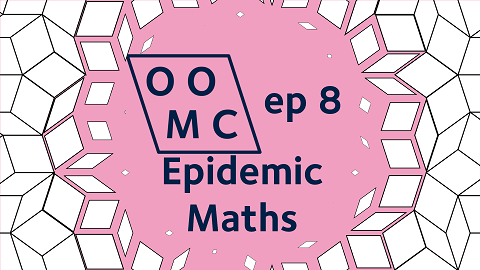Episode 8

In episode 8, Francesca tells us about her research on mathematical modelling of epidemics. There's also time for James to do something cryptic with knots.
Further Reading
Epidemics and the chain rule
Someone asked whether we could solve Francesca’s differential equations analytically. Here’s an application of the chain rule that gets us most of the way! If you haven’t seen episode 7 where we covered a primer on the chain rule, you can watch that here.
Francesca’s model includes the equations
$$
\frac{\mathrm{d}S}{\mathrm{d}t}=-\beta S I, \quad \text{and},\quad\frac{\mathrm{d}I}{\mathrm{d}t}=\beta S I - \mu I
$$
Let’s try to work out $\frac{\mathrm{d}I}{\mathrm{d}S}$ with the chain rule. We know that $\frac{\mathrm{d}I}{\mathrm{d}t}=\frac{\mathrm{d}I}{\mathrm{d}S}\frac{\mathrm{d}S}{\mathrm{d}t}$ by the chain rule, so we just need to divide the second equation by the first equation
$$
\frac{\mathrm{d}I}{\mathrm{d}S}=\frac{\beta S I - \mu I}{-\beta S I}
$$
This is a slightly odd thing to work out- it describes the way that the number of infected people changes as a function of the number of susceptible people during an outbreak. The disadvantage of doing this is that we’ve eliminated time; this equation doesn’t describe when anything happens (we would need to go back to the original pair of equations to infer that). But it does give us the shape of the pandemic. Mathematically, the advantage of doing this is that we can cancel $I$ from both sides, and then integrate with respect to $S$ to get
$$I=\frac{\mu}{\beta}\ln \left(\frac{S}{S_0} \right)–S +S_0+I_0$$
where $S_0$ and $I_0$ are the initial values of $S$ and $I$. This gives us a way to predict the maximum number of people who will be infected, if we can plot this function (see curve sketching below).
This is all from the deterministic (not random) model, and most of what Francesca said was to show you that a probabilistic (random) model can do a more realistic job of describing an outbreak.
If you’d like to know about other factors that go into COVID-19 modelling, there’s a very informative article by Kit Yates at https://theconversation.com/how-to-model-a-pandemic-134187.
Knots
The pictures I was drawing by crossing lines over each other are called “braids”. The idea of sticking the ends of the lines together makes it a closed braid, and you can use this to generate knots. Wolfram MathWorld has a nice introduction to Knot Theory here; https://mathworld.wolfram.com/KnotTheory.html
The question I asked on the livestream is essentially “what knot do you get when you do twist two strings together three times and stick the ends together”.
To get an idea of what different knots might look like, see (for example)
Determining whether a given knot can be smoothly deformed into another is very difficult- we don’t know an algorithm that can do this quickly. Prof Marc Lackenby at the University of Oxford has recently made some exciting progress https://www.maths.ox.ac.uk/node/38304.
Curve sketching
$$\text{(a)}\quad y=A \ln(x)-x$$
If you know how to differentiate $y=\ln x$, then you can find the maximum of this function.
$$\text{(b)}\quad y=\left(\frac{a}{x}\right)^{12}-\left(\frac{a}{x}\right)^6$$
Can you find the minimum of this function? This is used to model intermolecular forces.
If you want to get in touch with us about any of the mathematics in the video or the further reading, feel free to email us on oomc [at] maths.ox.ac.uk.

